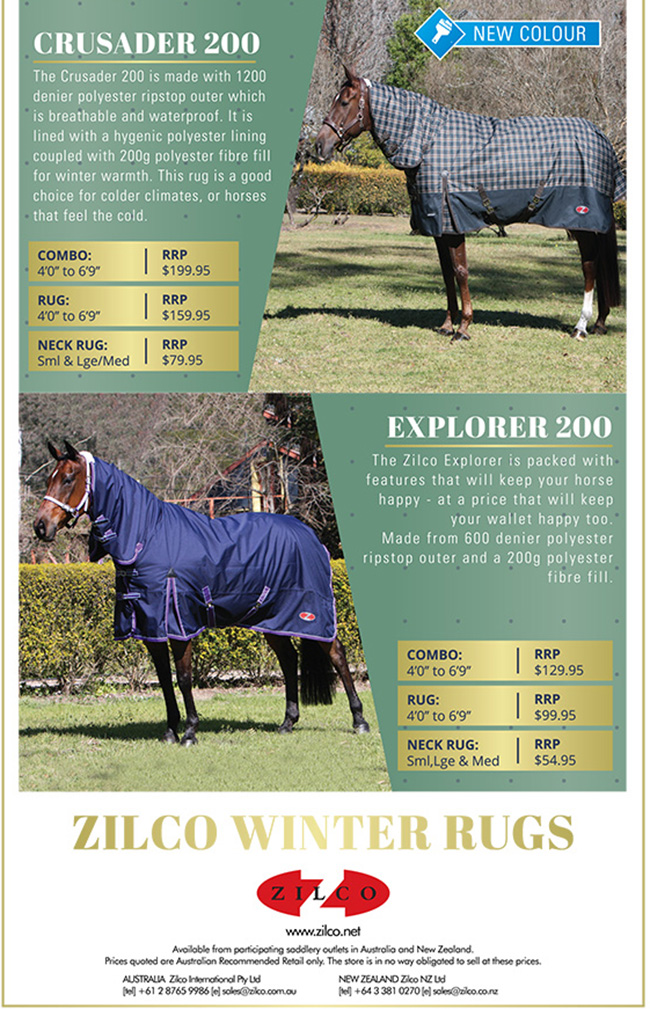Photos by Julie Wilson and Roz Neave
They have dominated the Australian Showjumping scene over the past twelve months and now they are off to Europe. First step for Chris Chugg on the road to Rio and his first Olympic Games, another step along the way for Gabi Kuna as she aims to achieve her goal – the WEG in Bromont. Just before they left, they recorded this exclusive interview with Chris Hector – the first question came from Roz Neave…
You’ve got two very different types of horses… How do you train them to get the best out of the two types? Looking back to the George Morris clinic when Gabi first brought Cristalline when you hadn’t had her long, and Chris said to me look at this mare, she’s amazing, you must take a photo. But I found it really hard to get a photo of her because she was – not untidy exactly, but nothing like she is now. I couldn’t see what you could see, so my question is how did you pick her?
“When we tried her, she’s a horse that wants to work herself all the time, a bit like a working dog. With the stallion, I have to make it interesting enough for him that he finds it easy and he’s happy about being forward. Cristalline likes to be forward and busy.”

Gabi and Cristalline, and Chris and Cera Cassiago – “they are both riders’ horses”
“When we went to try her, what Gabi needed was a horse that had lots of scope and lots of rideability and a nice character. It’s no good having a Warmblood that you’ve got to ride like a guy when you’re a girl, and Cristalline fitted the bill really well. I must admit she has surprised both of us, surprised us in a nice way, she’s a better horse than the one we bought. She just trains herself basically, we just manage her. What you see in the end product is a combination of a horse and rider that knit perfectly together.”
“The mare had great quality, we probably tried her over a metre thirty five, a small one forty, and she was a green five year old. She had been in work for about six weeks, preparing for us to see her. She had been worked and jumped under saddle for that time. She has grown into a much stronger type than what we bought. She was about 16.1 when we bought her, she’s 16.3 now. We basically work her in straight lines and relax her. When she is relaxed, that’s when she gives you the jump. When you see her a little bit uptight, fresh and buzzy, then she sometimes gets very high over fences and can make a few mistakes on the back rail.”
“I think it was good, the time I rode her when Gabi was injured, because she got to compete in the bigger classes and every weekend was a question for her. She is a horse that needs to be kept concentrating, so the bigger classes really made her concentrate and focus. When Gabi started her in a few of the bigger classes earlier in the season, before she got hurt, the mare over-reacted a little. But when I rode her for that time, she centred herself, and when Gabi got back on, everything just fell into place, it was perfect.”
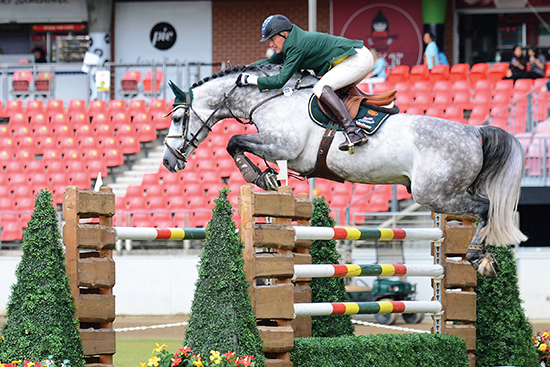
Cassiago, a bit of a diesel…
“The stallion needed to be challenged in a different way. He needed to be taught to be more of a forward thinker, and to travel with self-carriage. Not riding his neck down all the time. He’s a Holstein horse, so probably the more you lower the neck, the more the back legs are out behind. He’s a horse that I tend to ride a little above the bit. I think we’re lucky with the combination, he’s a bit of a diesel and she’s a bit electric. When I get on her, it is always whoa whoa whoa, with him it’s always, cluck cluck cluck. They are both riders’ horses.”
“Gabi’s had some serious interest in the horse from America, so she has had to make a few decisions. She’s decided that we’ll take her to Europe and she is going to ride her through the shows, and make that sort of decision at the end of the year, but her plan is still to go to the WEG in Canada.”
What do you do at home, what does the training look like?
“We do lots of different training. We do our flatwork, and we do our jump training, but we do probably only 5% jump training. A lot of it is swimming, we swim the mare a lot because she’s got a big barrel. She looks as though she’s had a foal occasionally when you see her coming out of the paddock. We are very conscious that the horses have to be fit. We are quite happy to have our horses fitter than most. It means you’ve got to put up with a lot of energy happening on the first day of the show. We swim three days a week, and we flatwork every day. We swim them at Gary White’s behind the Hawkesbury racecourse, it is just a big hole in the ground, like a key hole. You walk them in at one end and there is a fifteen metre circle at the end, you loop them – two people swim them, one on each side.”
“The Tuesday, Wednesday, Thursday after a big Grand Prix, up to Wednesday they might be in the paddock, then Wednesday we’ll take them for a swim, Thursday we might flat them and then go straight to the show with no jump. But we’ve got legwork, they are cross-trained, they are interval trained a bit. We do a lot of gallop, 400 metres a minute, so medium canter standing up. We don’t do a lot of circle work because at the end of the day you want something to present for sale that is clinically perfect for x-rays and vet checks, and so we are very wary of circles. Both of them are big horses, Cassiago weighs 620kg, the mare is close to 580 / 600kg, turning on those legs is not a good idea. They have enough work, concussion work all them time, living in Australia – the World Cups are very varied, and you have to put up with the different surfaces. I think, what we are really going to see when we hit Europe, is the difference of having the horses on the synthetic surfaces. We have tried them on it, when I first bought Cassiago, I took him down to Winning’s place, they have the surface there – and there was an amazing difference in the horse, having that stability under him where the ground doesn’t move, and gives him good cushioning and support. He’s going to love it, and I think Gabi’s mare will too.”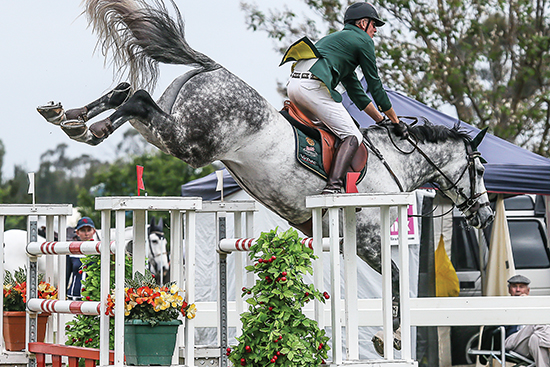
“Cassiago can really swim, easy a hundred metres…”
“We can get out of having to wear studs all the time, that’s something that unfortunately we have to do in Australia, even if it is a great surface, it can be slippery. There is wear and tear whenever you use studs, so I think Europe is going to be great for the horses, and keeping them sound over the next couple of years is just about having a good exercise program. By swimming them, you take the weight off their legs and nothing brings a horse’s stomach up and makes them round through the back, like swimming. Both horses come out of the pool and their stomachs are three inches higher. Cassiago can really swim, easy a hundred metres, and he comes out of the pool, two deep breaths and he stops blowing.”
“We’ve been breeding Gabi’s mare and trying to get embryos, so she’s been worked very little and we can’t swim her, and we notice now that we haven’t swum her for three weeks, she blows. With three swims and a couple of flatworks, she’ll be ready for a big class again.”
“Another reason we like to have our horses really fit, in case something goes wrong. I learnt that eventing – Gawler 3DE. I had a horse, Custah , a big Anglo Arab. I won the under 17-year-old class there, but in the lead up he had sprained a fetlock, and the vet said, don’t worry, he’ll come good because he is so fit. He’d had twelve weeks of preparation, ten days off, I floated him to the event and worked him, and he went round the three day perfectly. You learn to interval train, and that’s what a lot of people don’t do, they stick to their small arenas and they don’t vary the education of the horses and develop their muscles. That’s the only thing we are going to miss in Europe – swimming the horses. But we will try, I think some of the trotting farms will have swimming pools.”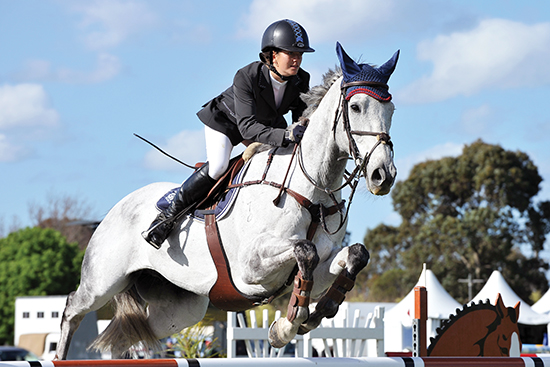
Gabi and Thoroughbred, Diamond B Jimmy Choo, “she made her first Grand Prix horse, a Thoroughbred, and she sold that to buy Cristalline”
Looking at the Australian scene at the moment, are you happy with where we are now?
“I think it is fabulous. Gabi and I know what we have won this year, and I’ve probably won five times more than I won with Mr Currency and Vivant. Our two horses have won about $50,000 in prizemoney this year. Other years when I won ten world cups in the row, I only won about ten thousand and it probably cost me about $25,000 to do that. We’ve probably covered our expenses this year, traveling to Brisbane, Adelaide twice, Melbourne, covered expenses, put a new diff and new tyres on the truck, maybe even came out with a profit. It’s great to see that the sport has grown and some money has come into it, whether it’s through good forward planning, or just the way the wheel rolls some times. You get Alan Bond, or Tempo, and some money comes into the sport and all of a sudden, it goes out. But this time it seems to have come from different sources and different sponsors, and I think it is a healthy development.”
“If we could come back next year and earn $100,000 for the year, you would probably keep a million dollar horse for that. If that kept snowballing for seven years, you are basically getting back half of what you would have sold him for in prizemoney. I think it is exciting. As I say, Gabi has had some nibbles from America, but her plan is to get through to Canada, and it is a healthy scene right here in Australia.”
And the riding and training – is that heading in the right direction?
“It’s progressive enough in that you always have the same trainers in the sport, and you are getting new young riders in the sport all the time. We work a little differently. Gabi is a New Age rider is far as I am concerned. She has got to the peak of the sport in ten years, and a lot of people don’t fast track kids with that much talent. Gabi has certainly been fast tracked, from eventing to showjumping, and in the last three years, I’ve watched her go from her first Grand Prix horse to Cristalline. She made her first Grand Prix horse – a Thoroughbred I sold her, and then she sold that horse to buy Cristalline. There are trainers out there who can train people to get to a high level, and there are some great young riders here, but it is very important, that while the parents have got the money and the interest to sponsor the kids, that those kids get there quickly, without losing the fundamentals of the training philosophy.”
“Showjumping is a sport that is moving forward all around the world and I think it is growing here – the prizemoney we were able to win this year, we had to earn it, we had two Grand Prix horses on the circuit – it is a healthy industry now and hopefully it keeps moving forward.”
Horse-wise, you are still buying horses in Europe, why not Australia?
“I don’t think there is anything wrong, we are just ten years off… I found Cassiago here, but he was imported, and Cristalline is imported. I think there is an opportunity here, but the dam lines are the biggest factor. We are fairly lucky that we have a new mare Chantilly (Chacco Blue/Baloubet du Rouet/Cento) who was bred at Lewitz, Schockemöhle’s breeding farm. She is very closely related to the mare who was just sold for 1.6 million, and she looks like her when she jumps. We are flushing embryos out of her at the moment, and we are collecting from Cristalline. Gabi is lucky enough to have a yearling filly out of Cristalline by Emerald. I bred one out of Cristalline by Conquistador, which Melissa Froesch bought.”
“I also have a very nice mare I bought from Kerri Parker, by Clearway – Carlina, she has had her first two starts in Mini Prix, and she is jumping them like Cristalline does. We’ve also got four embryos out of her, three to Cassiago and one to Diarado. I think we’ve got the best brood mare herd of anybody. Leopoldo is trying to arrange for Alfonso Romo to get an embryo from Cristalline when we go to Europe, so the eyes are out there. We are very keen to keep getting the embryos from the mares, we are probably have six foals this year out of three great mares.”
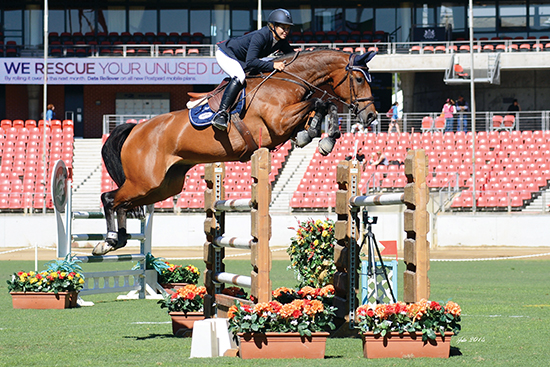
And in case you had the impression that Gabi is ‘just’ Chuggy’s girl, may I assure you that she is a very determined and thoughtful individual. It’s Gabi who outlines the breeding program:
“The mares, I think, are just so important and that’s maybe what we’ve lacked in the past to breed really top ones. Kerri Parker does a fantastic job, she’s got a great knowledge of breeding and it all comes down to her mare lines, that’s all she talks about – and she has the good mares from Europe. We are so fortunate here, in that we can raise our young stock outside, sound horses, strong horses. The mare line is just what we’ve lacked in the past, and the more people that breed out of their good quality mares, either proven in sport or with good quality lines, it is really going to improve the jumping stock of Australia. Alice Cameron is the same, she has always used Hilary’s good performance mares to get the embryos and they are just coming through now. We have yet to see the best of them, but it is only going to get stronger. We’ve always had Thoroughbred stock, which is also important because you need that blood for modern sport, but that needs to be a bit back, then you need that really sharp mare line to improve the jump again, and that is going to come out in the next few years. I think Australia will have some really top horses that have been bred here, but it is just that process and time.”
This article first appeared in the March 2016 issue of THM.
For more with Chris Chugg, go to:


